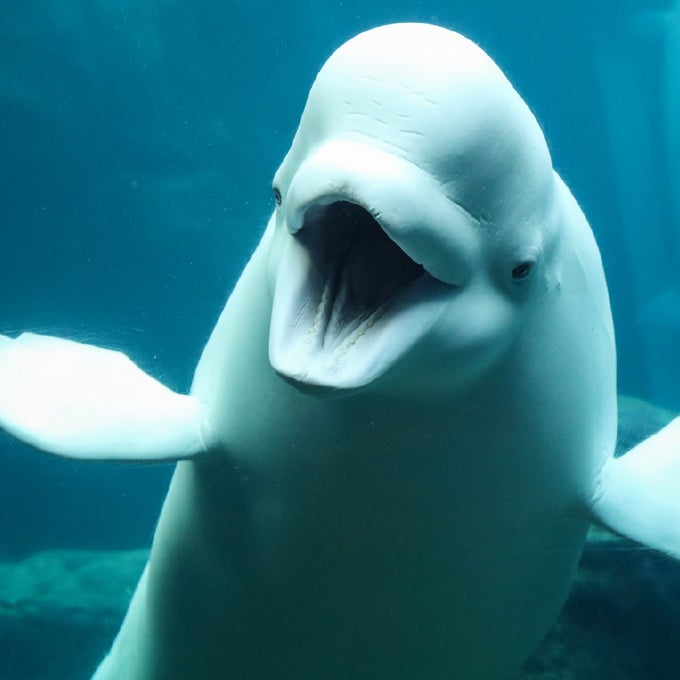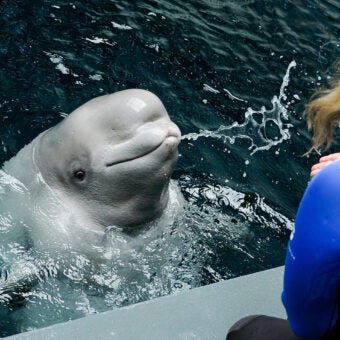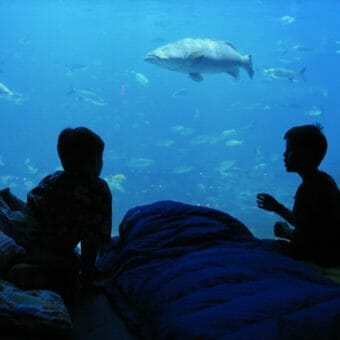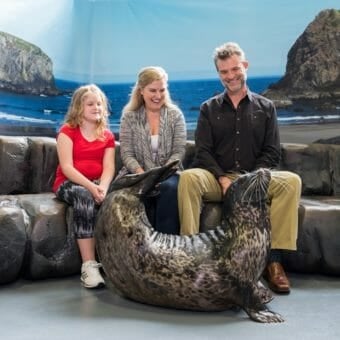-
Size
11-15 feet (3.4-4.6 m) -
Diet
Fish, mollusks, crustaceans and even zooplankton -
Range
Found throughout the Arctic -
Habitat
Varies from deep offshore waters to shallow bays and estuaries
Physical Characteristics
- Unfused cervical vertebrae allows for neck flexibility. This adaptation allows for maneuverability in shallow water to hunt and to escape from predators.
- Very thick layer of blubber, thick skin, relatively small tail flukes and pectoral flippers, and absence of a dorsal fin are adaptations for life in cold water.
- The melon is the rounded structure on the top of the beluga’s head, just in front of the blowhole. It is composed of lipids (fats) and can change shape when the whale is producing sounds. The melon focuses and projects echolocation signals through the water. It is unique to toothed whales and not found on baleen whales.
- Lips can be pursed to form the shape of an “O.”
- Tongue forms a tight seal around fish which allows the beluga to swallow prey without ingesting water.
- Rather than a dorsal fin, which would be prone to injury from ice and heat loss, a beluga has a dorsal ridge.
- Generally pale gray to pure white as adults, belugas are a light gray color at birth. Their light coloration is believed to camouflage the animal in snowy, icy surroundings.
- Areas such as the dorsal ridge, the edges of the pectoral flippers and the edges of the tail flukes may be darker on adult belugas.
- Average weight and length of an adult ranges between 1100-2500 lbs (499-1143 kg) and 11-15 feet (3.4-4.6 m).
- Average calf birth weight is 119-145 lbs (54-66 kg) and length is 4.5-5.1 feet (137-155 cm).
- The maximum adult weight reported is 3600 lbs (1633 kg).
- Belugas show sexual dimorphism, with males being approximately 25% larger than females.
- The beluga whale has 30-40 homodont (of similar size and shape), conical teeth.
- Teeth are not replaced if lost.
- A calf’s teeth begin to come in between 1 and 2 years of age.
- The teeth of Odontocetes contain growth rings, called “Growth Layer Groups” (GLG).
Animal Fact
Belugas are sometimes called “sea canaries” due to the extensive variety of sounds they can make!
Diet / Feeding
- The diet of a beluga whale is the most diverse of any of the smaller whales. Diets of subpopulations are regionally and seasonally influenced.
- They are opportunistic feeders, and will consume over 100 species of marine and freshwater fish, mollusks, crustaceans, and even zooplankton.
- Belugas do not chew. Larger prey may be torn into smaller pieces, but most food is swallowed whole.
- Belugas can hunt cooperatively to conserve energy.
- Spit and suction behaviors allow belugas to catch benthic (seafloor region) prey.
Range / Habitat
- Found throughout the Arctic with some subarctic populations such as the St. Lawrence and Amur rivers.
- From Svalbard, Norway around to the west coast of Greenland.
- Although all belugas are considered the same species, they are sometimes further referred to as subpopulations, that may be genetically and/or geographically isolated from other subpopulations (i.e. Cook Inlet stock, Ungava Bay stock, St. Lawrence River stock, Bristol Bay stock, etc.)
- Belugas can be found in a wide variety of environments, from deep offshore waters to shallow bays and estuaries; even ranging far upriver.
- Can travel back and forth between fresh and salt water.
Reproduction & Growth
- Females mature between 5-7 years of age, males between 8-9 years of age
- Reproductive cycle is strictly seasonal, though there is slight variability between regions.
- Observed in human care, gestation ranges from 15-16 months.
- Births occur most often from late spring to early summer: April – July.
- Belugas give birth to one calf at a time.
- Females give birth every 2-4 years.
- An average birth lasts eight hours.
- Calves may not successfully nurse until more than a day after birth.
- Once nursing, belugas nurse about every half hour, though there may be variation from calf to calf.
- Calves curl their tongue, similar to humans, which is used as a straw for nursing. When curled a water-tight seal is formed by the scalloped edges around the tongue.
- A female beluga can lactate (produce milk) for approximately 2 years following the birth of her calf.
- Calves are dependent upon their mother’s milk for the first 6-12 months of life before they begin to eat solid food, but can continue to nurse opportunistically until they are 2 years of age.
Conservation Status
- “Least Concern” on the IUCN Red List – this is for the species as a whole.
- “Critically Endangered” – Cook Inlet stock
- “Endangered” – Ungava Bay and East Hudson Bay stocks
- “Threatened” – St Lawrence River stock
- Although it is estimated that there are more than 150,000 belugas worldwide, some subpopulations are endangered. One example of this is the Cook Inlet stock: being isolated geographically as well as genetically, the belugas of this subpopulation are particularly vulnerable.
- Another population, the beluga whales in Bristol Bay, was believed to be approximately 1,000 to 1,500 belugas in the year 1950. Based on aerial surveys it appears the population increased approximately 65% between 1993 and 2005.
Additional Information
Social Units
- Belugas are gregarious, and often hunt and interact in groups. Some stocks are migratory, and some are not.
- It is common for belugas to form groups, called “pods”, of two to several dozen individuals.
- Pod structures are very fluid, with individuals moving between different pods.
- The mother/calf bond is thought to be the central social relationship for belugas.
- Pods can join to form herds of several hundred animals at a time.
- Pods often consist of the same sex and age class.
- Males often travel in tight pods of 10 -15 individuals. Females and their young form pods, with calves sometimes remaining with their mothers for 4-5 years or more.
- Females without young tend to form pods.
- Older subadults can also be found together.
Skin
- Beluga skin is ten times thicker than dolphin skin and one hundred times thicker than terrestrial mammal skin.
- A calf’s skin is thicker upon birth to compensate for the lack of blubber. As the calf develops a thick layer of blubber, the skin is shed.
- The white color of a beluga’s skin is thought to provide camouflage among sea ice.
- Belugas are constantly sloughing their skin, but also experience an annual molt, which is unique among cetaceans. This may be triggered by environmental cues such as temperature and salinity.
- Belugas have well-developed skin sensitivity which plays an important role in tactile-oriented social behavior.
Blubber
- Below the skin is a thick insulating layer of blubber which is considered unusually thick when compared to other Odontocetes (toothed whales). This layer of blubber is one of the beluga’s greatest adaptations to life in the freezing temperatures of the Arctic.
- Blubber accounts for 40-50% of their body weight.
- Typical thickness of blubber is 4 inches (10 cm), but thicknesses of up to 10.6 inches (27 cm) have been reported.
- Thickness varies seasonally.
Vision
- The beluga whale has good vision below and above the water surface.
- Oily mucus is secreted that protects the eyes, washes away debris and possibly streamlines the eye as the beluga swims.
- Scientists are unsure if the beluga possesses color vision. The eyes do contain both rods and cones; however, there is only one type of cone, and two or more is typically necessary for color vision.
Sleep State
- The beluga engages in unihemispheric slow wave sleep (USWS) in which one half of its brain is in a sleep state, while the other half maintains visual and auditory awareness of the environment, while allowing it to surface to breathe.
Swim Speed
- Adults routinely swim at speeds of about 2 to 6 mph (3 – 9 km/h).
- The maximum observed swim speed of a beluga whale is about 17 mph (27.5 km/h) for short distances.
- The beluga whale can swim backwards. This adaptation is helpful in an environment where sea ice can change rapidly.
Dives/Depths
- Most dives range between 9-18 minutes.
- Feeding dives last 18-20 minutes, rarely lasting longer.
- Dives lasting up to 25 minutes have been recorded.
- Belugas can reach depths of 3,300 ft. (1,000 m) in their natural environment.
Hearing
- The beluga whale has acute hearing, and can detect sounds ranging from 1.2 to 120 kHz.
- Small external ears on the sides of the head may be useful for detecting low frequency sounds, but high frequency sounds are mainly received through a fat-filled canal in the lower jaw.
Smell
- The beluga’s brain lacks an olfactory system (sense of smell).
Vocalization
- Called “sea canaries” due to an extensive repertoire of sounds. Belugas have the most diverse vocal repertoire of all cetaceans.
- Their diverse repertoire is composed of the predominant sound types among toothed whales: whistles, clicks, chirps, groans, trills, buzzes, roars.
- Increased vocalizations have been observed during social interactions.
- “Contact calls,” broad-band pulsed vocalizations associated with bonding, play an important role in establishing or maintaining contact between mothers and calves.
- Adept at mimicking sounds. This ability suggests that they may use vocal learning in developing their natural vocalizations.
Echolocation
- Click-like pulses produced by the beluga are used for echolocation, a sort of biological sonar. The bounce-back from these signals is received in the fat-filled channel in the lower jaw bone and transmitted to the inner ear, which sends nerve impulses to the brain.
- Echolocation allows the animal to locate prey, identify predators and navigate in dark or murky water. This is especially useful to the beluga in shallow freshwater environments as well as among sea ice.
- Using echolocation, a beluga can determine an object’s size, shape, structure, composition, speed, distance, and direction.
- Echolocation may be used to determine how deep a beluga must dive to reach the bottom before initiating the dive.
- The beluga can change the frequency of its clicks in the presence of background noise to better utilize its echolocation.
Threats
- The accumulation of chemicals and heavy metals released into the environment by human activities continues to impact beluga populations both directly and indirectly. They are at the top of the food chain and thus are exposed to more highly-contaminated prey.
- Polar bears and killer whales are two major predators of beluga whales, although neither of these is considered a significant threat to beluga populations as a whole.
- Becoming trapped in ice is not uncommon, and groups of belugas large enough to have an effect on the population can become restricted to small areas by shifting sea ice.
- Climate change resulting in less ice in northern waters could potentially lead to increased fishing and sea traffic, which could threaten belugas with higher levels of pollution, decreased prey, and environmental disturbances.
- Intensive hunting in certain parts of their range (Canada and Greenland).
Beluga Whale Gifts from Georgia Aquarium
Bring the memories home with you! Stop by our gift shop for all your beluga whale gifts or shop online here.
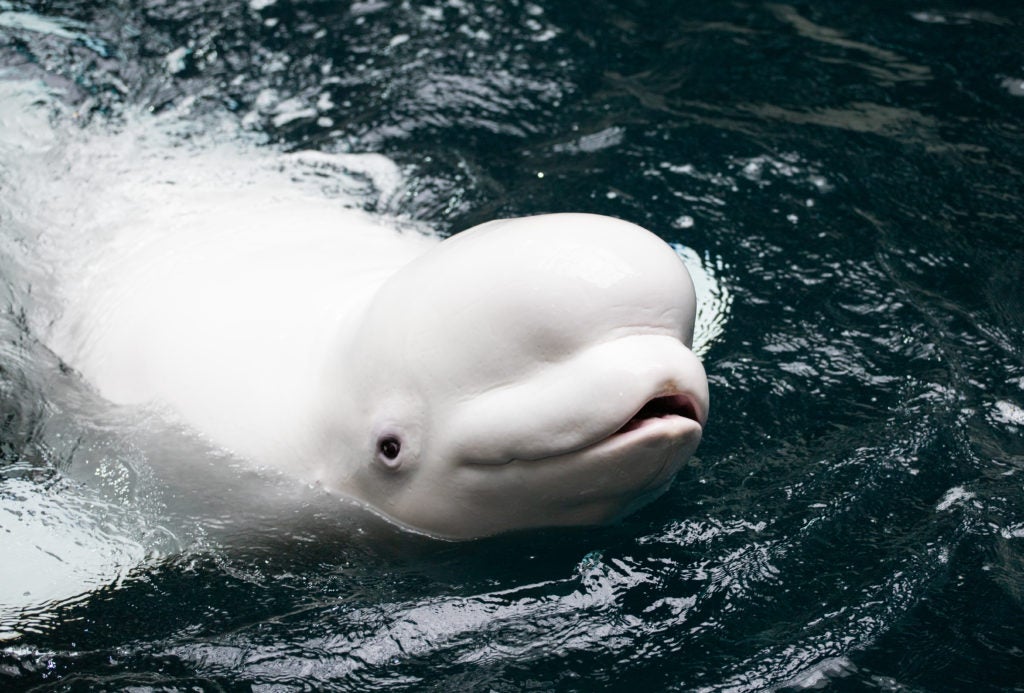
Beluga Paintings Now Available!
Artists come in all different shapes, sizes and species! For the first time, you can purchase a unique piece of art that serves as an incredible conversation piece, or an unforgettable gift. Pieces are created by our animals getting in touch with their inner artist during one of their favorite types of enrichment – painting! Learn more here.

Sources
- Alaska Marine Mammal Stock Assessments, 2008. http://www.nmfs.noaa.gov/pr/pdfs/sars/ak2008whbg-bb.pdf
- Balsiger JW. 2003. Subsistence Harvest Management of Cook Inlet Beluga Whales: Final Environmental Impact Statement. National Marine Fisheries Service, Alaska Region, NOAA.
- Brodie PF. 1971. A reconsideration of aspects of growth, reproduction, and behavior of the white whale (Delphinapterus leucas) with special reference to the Cumberland Sound, Baffin Island, population. Journal of the Fisheries Research Board of Canada28: 1309-1318.
- Brodie, Paul F. The White Whale Delphinapterus leucas (Pallas, 1776). 1989. In Handbook of Marin Mammals, Vol. 4: River Dolphins and Larger Toothed Whales. Ridgway S. H., and R. J. Harrison [ed.]. Academic +Press, London.
- Burns JJ and Seaman GA. 1988. Investigations of beluga whales in coastal waters of western and northern Alaska. Outer Continental Shelf Environmental Assessment Program. Alaska Department of Fish and Game.
- Committee on the Status of Endangered Wildlife in Canada (COSEWIC). 2004. COSEWIC assessment and update status report on the beluga whale Delphinapterus leucas in Canada. COSEWIC: Ottawa. ix + 70 pp.
- Doidge DW. 1990. Integumentary heat loss and blubber distribution in the beluga, Delphinapterus leucas, with comparisons to the narwhal, Monodon monoceros. In: Smith TG, St. Aubin DJ and Geraci JR (Eds.). Advances in research on the beluga whale, Delphinapterus leucas. Canadian Bulletin of Fisheries and Aquatic Sciences224.
- Dudzinski KM, Thomas JA, Douaze E. 2002. Communication. In: Perrin WF, Würsig B and Thewissen JGM (Eds.). Encyclopedia of Marine Mammals. Boston: Academic Press. 1414 pp.
- Fish MP and Mowbray WH. 1962. Production of underwater sound by the white whale or beluga, Delphinapterus leucas (Pallas). Journal of Marine Research 20(2): 149-161.
- Frankel AS. 2002. Sound production. In: Perrin WF, Würsig B and Thewissen JGM (Eds.). Encyclopedia of Marine Mammals. Boston: Academic Press. 1414 pp.
- Goley PD. 1999. Behavioral aspects of sleep in Pacific white-sided dolphins (Lagenorhynchus obliquidens, Gill 1865). Marine Mammal Science 15(4): 1054-1064.
- Griebel U and Peichl L. 2003. Color vision in aquatic mammals-facts and open questions. Aquatic Mammals 29(1): 18-30.
- Gurevich VS. 1980. Worldwide distribution and migration patterns of the white whale (beluga), Delphiapterus leucas. Reports of the International Whaling Commission 30: 465-480.
- Harley HE, Xitco Jr MJ, and Roitblat HL. 1995. Echolocation, cognition, and the dolphin’s world. In: Kastelein RA, Thomas JA, and Nachtigall PE (Eds.). Sensory Systems of Aquatic Mammals. The Netherlands: De Spil Publishers. p. 529-542.
- Heide-Jorgensen MP, Richard PR and Rosing-Asvid A. 1998. Dive patterns of belugas (Delphinapterus leucas) in waters near Eastern Devon Island. Arctic 51(1): 17-26. http://pubs.aina.ucalgary.ca/arctic/Arctic51-1-17.pdf
- International Whaling Commision (IWC). 2000. Report of the sub-committee on small cetaceans. Journal of Cetacean Research and Management 2(Supplement): 243-250
- Ivashin MV and Shevlyagin KV. 1987. The white whale (Delphinapterus leucasPallas, 1776): Entrapment and escape in the ice of Senjavin Strait, USSR. Reports of the International Whaling Commission 37: 357-359.
- Jefferson, T.A., Karczmarski, L., Laidre, K., O’Corry-Crowe, G., Reeves, R.R., Rojas-Bracho, L., Secchi, E.R., Slooten, E., Smith, B.D., Wang, J.Y. & Zhou, K. 2008. Delphinapterus leucas. In: IUCN 2011. IUCN Red List of Threatened Species. Version 2011.2. <www.iucnredlist.org>. Downloaded on 16 May 2012.
- Katona SK, V Rough and DT Richardson. 1993. A Field Guide to Whales, Porpoises, and Seals from Cape Cod to Newfoundland, 4th Edition, Revised. Washington: Smithsonian Institute Press. 316 pp.
- Kleinberg SE, Yablokov AV, Bel’kovich BM and Tarasevich MN. 1969. Beluga(Delphinapterus leucas): Investigation of the Species. Israel Program for Scientific Translations. 376 pp.
- Klishin VO,Popov VV and Supin AY. 2000. Hearing capabilities of a beluga whale, Delphinapterus leucas. Aquatic Mammals 26(3): 212-228.
- Krasnova VV, Bel’kovich VM, and Chernetsky AD. 2006. Mother-infant spatial relations in wild beluga (Delphinapterus leucas) during postnatal development under natural conditions. Biology Bulletin 33(1): 53-58
- Leatherwood S, Reeves RR, Perrin WF, and Evans WE. 1988. Whales, Dolphins, and Porpoises of the Eastern North Pacific and Adjacent Arctic Waters. New York: Dover Publications, Inc. 245 pp.
- Leung SL, Vergara V, Barrett-Lennard LG (2010) Allonursing in Captive Belugas (Delphinapterus leucas). Zoo Biology 29:1-5
- Loseto LL, Richard P, Stern GA, Orr J and Ferguson SH. 2006. Segregation of Beaufort Sea beluga whales during the open-water season. Canadian Journal of Zoology 84: 1743-1751.
- Loseto LL, Stern GA, and Ferguson SH. 2008. Size and biomagnification: How habitat selection explains beluga mercury levels. Environmental Science & Technology 42(11): 3982-3988.
- Lowry LF, Burns JJ and Nelson RR. 1987. Polar bear, Ursus maritimus, predation on belugas, Delphinapterus leucas, in the Bering and Chukchi Seas. Canadian Field-Naturalist 101(2): 141-146.
- Lyamin OI, Mukhametov LM, Siegel JM, Nazarenko EM, Polyakova IA and Shpak OV. 2002. Unihemispheric slow wave sleep and the state of the eyes in a white whale. Behavioral Brain Research 129(1-2): 125-129.
- Marine Mammal Inventory Database
- Martin AR and Smith TG. 1999. Strategy and capability of wild belugas, Delphinapterus leucas, during deep, benthic diving. Canadian Journal of Zoology 77: 1783-1793.
- Martin AR, Hall P and Richard PR. 2001. Dive behavior of belugas, Delphinapterus leucas) in the shallow waters of Western Hudson Bay. Arctic 54(3):276-283
- Martin T. 1996. Beluga Whales. Voyager Press: Stillwater, Minnesota. 72pp.
- Mass AM and Supin AY. 2002. Visual field organization and retinal resolution of the beluga, Delphinapterus leucas (Pallas). Aquatic Mammals 28(3): 241-250.
- Moore PWB, Pawloski DA and Dankiewicz L. 1995. Interaural time and intensity difference thresholds in the bottlenose dolphin (Tursiops truncatus). In: Kastelein RA, Thomas JA, and Nachtigall PE (Eds.). Sensory Systems of Aquatic Mammals. The Netherlands: De Spil Publishers. p. 11-25.
- O’Corry-Crowe GM. 2002. Beluga whale. In: Perrin WF, Würsig B and Thewissen JGM (Eds.). Encyclopedia of Marine Mammals. Boston: Academic Press. 1414 pp.
- Reeves RR, Stewart BS, Clapham PJ, and Powell JA. 2002. National Audubon Society Guide to Marine Mammals of the World. New York: Alfred A. Knopf. 528 pp.
- Reidenberg JS and Laitman JT. 2002. Prenatal development in cetaceans. In: Perrin WF, Würsig B and Thewissen JGM (Eds.). Encyclopedia of Marine Mammals. Boston: Academic Press. 1414 pp.
- Richard P. 2002. Underwater World: Beluga. Fisheries and Oceans Canada. www.dfo-mpo.gc.ca.
- Richard PR, Heide-Jorgensen MP and St. Aubin DJ. 1998. Fall Movements of belugas (Delphinapterus leucas) with satellite-linked transmitters in Lancaster Sound, Jones Sound and northern Baffin Bay. Arctic 51(1): 5-16.
- Richard PR, Heide-Jorgensen MP, Orr JR, Dietz R and Smith TG. 2001. Summer and autumn movements and habitat use by belugas in the Canadian High Arctic and adjacent areas. Arctic 54(3): 207-222.
- Ridgway SH and Carder DA. 1998. Net-aided foraging by two white whales. Marine Mammal Science 14(2): 332-334.
- Robeck TR, Monfort SL, Calle PP, Dunn JL, Jensen E, Boehm JR, Young S and Clark ST. 2005. Reproduction, growth and development in captive beluga (Delphinapterus leucas). Zoo Biology 24: 29-49.
- Russell JM, Simonoff JS and Nightengale J. 1997. Nursing behaviors of beluga calves (Delphinapterus leucas) born in captivity. Zoo Biology 16:247-262.
- Schevill WE and Lawrence B. 1949. Underwater listening to the white porpoise (Delphinapterus leucas). Science 109: 143-144.
- Schreer JF and Kovacs KM. 1997. Allometry of diving capacity in air-breathing vertebrates. Canadian Journal of Zoology 75: 339-358.
- Sergeant DE. 1973. Biology of white whales (Delphinapterus leucas) in western Hudson Bay. Journal of the Fisheries Research Board of Canada 30: 1065-1090.
- Shaffer SA, Costa DP, Williams TM and Ridgeway SH. 1997 Diving and swimming performance of white whales, Delphinapterus leucas: an assessment of plasma lactate and blood gas levels and respiratory rates. Journal of Experimental Biology 200: 3091-3099.
- Shelden KEW, Rugh DJ, Mahoney BA, and Dahlheim ME. 2002. Killer whale predation on belugas in Cook Inlet, Alaska: Implications for a depleted population. National Marine Mammal Laboratory, Alaska Fisheries Science Center, National Marine Fisheries Service, NOAA. http://nmml.afsc.noaa.gov.
- Sjare BL and Smith TG. 1986. The relationship between behavioral activity and underwater vocalizations of the white whale, Delphinapterus leucas. Canadian Journal of Zoology 64: 2824-2831.
- Smith TG, Hammill MO and Martin AR. 1994. Herd composition and behavior of white whales (Delphinapterus leucas) in two Canadian arctic estuaries. Meddelelser om Grønland, Bioscience 39: 175-184.
- St. Aubin DJ, Smith TG and Geraci JR. 1990. Seasonal epidermal molt in beluga whales, Delphinapterus leucas.Canadian Journal of Zoology 68: 359-367.
- Turl CW, Penner RH, Au WWL (1987) Comparison of target detection capabilities of the beluga and bottlenose dolphin. Journal of the Acoustical Society of America 85:1487-1491
- Tyack PL (1993) Animal language research needs a broader comparative and evolutionary framework. In: Roitblat HL, Hermman LM, Nachtigall PE (eds) Language and Communication: Comparative Perspectives. Lawrence Erlbaum Associates, Hillsdale, New Jersey, pp 115-152
- Vergara V, Michaud R, Barrett-Lennard LG (2010) What can captive whales tell us about their wild counterparts? Identification, usage and ontogeny of contact calls in belugas (Delphinapterus leucas). International Journal of Comparative Psychology 23:278-309
- Wagemann R, Stewart REA, Beland P and Desjardins C. 1990. Heavy metals and selenium in tissues of beluga whales, Delphinapterus leucas, from the Canadian arctic and the St. Lawrence Estuary. In: Smith TG, St. Aubin DJ and Geraci JR (Eds.). Advances in research on the beluga whale, Delphinapterus leucas. Canadian Bulletin of Fisheries and Aquatic Sciences 224.
- Wilson JY, Cooke SR, Morre MJ, Martineau D, Mikaelian I, Metner DA, Lockhart WL, and Stegeman JJ. 2005. Systemic effects of Arctic pollutants in beluga whales indicated by CYP1A1 expression. Environmental Health Perspectives 113(11): 1594-1599.
- Brodie, P., K. Ramirez and M. Haulena. 2013. Growth and maturity of belugas (Delphinapterus leucas) in Cumberland Sound, Canada, and in captivity: evidence for two growth layer groups (GLGs) per year in teeth. J. Cetacean Res. Manage 13(1):1-18.

